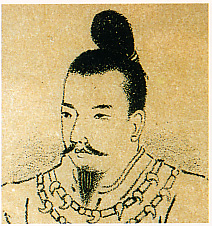Emperor Kōan
| Kōan | |
|---|---|
| Emperor of Japan | |
 |
|
| Reign | 392 BC – 291 BC (traditional) |
| Predecessor | Kōshō |
| Successor | Kōrei |
| Born | 427 BC |
| Died | 291 BC (aged 136) |
| Burial | Tamate no oka no e no misasagi (Nara) |
Emperor Kōan (孝安天皇 Kōan-tennō?); also known as Yamatotarashihikokunioshihito no Mikoto; was the sixth emperor of Japan, according to the traditional order of succession.
No firm dates can be assigned to this emperor's life or reign; he is conventionally considered to have reigned from 392 BC through 291 BC.
Modern scholars have come to question the existence of at least the first nine emperors; Suizei's descendant, Emperor Sujin is the first that many agree might have actually existed. The name Kōan-tennō was assigned to him posthumously by later generations.
Kōan is regarded by historians as a "legendary emperor" and there is a paucity of information about him. There is insufficient material available for further verification and study. The reign of Emperor Kinmei (c. 509 – 571 AD), the 29th emperor, is the first for which contemporary historiography is able to assign verifiable dates; However, the conventionally accepted names and dates of the early emperors were not to be confirmed as "traditional" until the reign of Emperor Kanmu (737–806), the 50th sovereign of the Yamato dynasty.
In the Kojiki and Nihonshoki only his name and genealogy were recorded. He is believed to be son of Emperor Kōshō; and his mother is believed to have been Yosotarashi-no-hime, who was the daughter of Okitsuyoso, and ancestress of the Owari. The Japanese have traditionally accepted this sovereign's historical existence, and an Imperial misasagi or tomb for Kōan is currently maintained; however, no extant contemporary records have been discovered that confirm a view that this historical figure actually reigned. He is considered to have been the fifth of eight emperors without specific legends associated with them, also known as the "eight undocumented monarchs" (欠史八代, Kesshi-hachidai?).
...
Wikipedia
